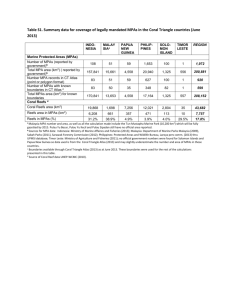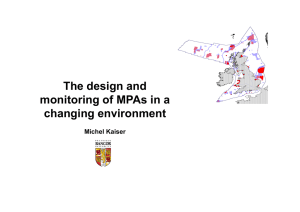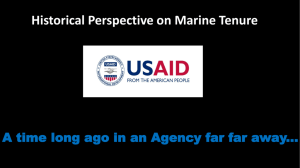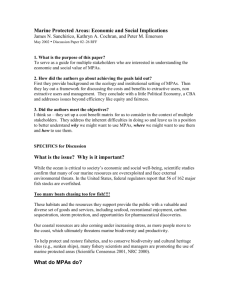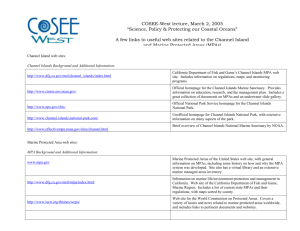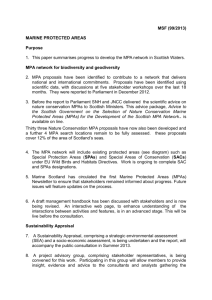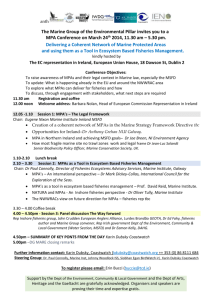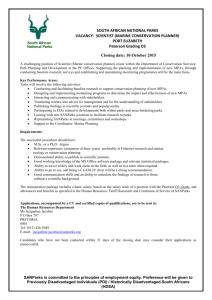THE N NORTH S We
advertisement
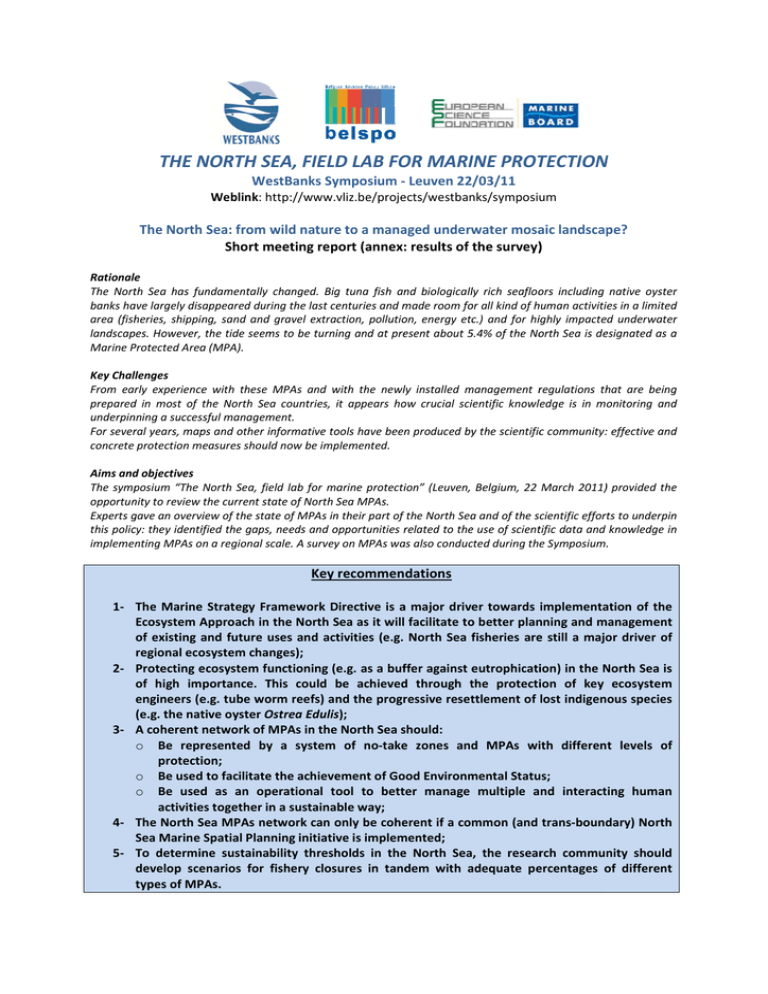
THE N NORTH SSEA, FIELD D LAB FO OR MARIINE PROTTECTION N We estBanks Syymposium ‐‐ Leuven 22/03/11 Weblink: h http://www.vvliz.be/projeects/westban nks/symposium The North Sea: from wild nature e to a manaaged underw water mosaaic landscap pe? meeting rep port (annex:: results of the survey)) Short m Rationalee The Nortth Sea has fu undamentally changed. Big g tuna fish an nd biologicallly rich seafloo ors including native oysterr banks ha ave largely disappeared durring the last ceenturies and m made room fo or all kind of h human activities in a limited d area (fish heries, shippin ng, sand and d gravel extracction, pollutio on, energy etcc.) and for hiighly impacted underwaterr landscap pes. However, the tide seem ms to be turniing and at preesent about 5 5.4% of the No orth Sea is deesignated as a a Marine P Protected Area a (MPA). Key Challlenges From earrly experiencee with these MPAs and with w the newlly installed management m rregulations th hat are being g prepared d in most of the North Sea countries, it i appears ho ow crucial sciientific knowlledge is in monitoring and d underpin nning a successful managem ment. For severral years, map ps and other iinformative to ools have been n produced byy the scientificc community:: effective and d concrete protection measures shoulld now be imp plemented. d objectives Aims and The symp posium “The North Sea, fieeld lab for ma arine protectiion” (Leuven, Belgium, 22 March 2011)) provided thee opportun nity to review the current sttate of North SSea MPAs. Experts g gave an overviiew of the sta ate of MPAs in n their part of the North Sea a and of the scientific efforts to underpin n this policcy: they identif ified the gaps,, needs and o opportunities rrelated to thee use of scienttific data and knowledge in n implemen nting MPAs on a regional sscale. A surveyy on MPAs wa as also conduccted during the Symposium.. Key recommendations 1‐ The Marine Strategy Frramework Directive D is aa major drive er towards implementaation of the Ecosystem A Approach in the North SSea as it will facilitate to o better plan nning and m management of existing aand future u uses and acttivities (e.g. North Sea fisheries f aree still a majo or driver of regional eco osystem changes); 2‐ Protecting e ecosystem fu unctioning (e e.g. as a bufffer against e eutrophicatiion) in the N North Sea is of high importance. This T could be b achieved d through the t protectiion of key ecosystem engineers (ee.g. tube wo orm reefs) an nd the progrressive resetttlement of lost indigenous species (e.g. the nattive oyster O Ostrea Eduliss); 3‐ A coherent network of M MPAs in the North Sea sshould: o Be reprresented byy a system of no‐take e zones and d MPAs wiith different levels of protectiion; o Be used to facilitate e the achieve ement of Go ood Environm mental Statu us; o Be used d as an op perational to ool to bettter manage multiple and interacting human activitiees together in n a sustainable way; 4‐ The North SSea MPAs ne etwork can o only be coheerent if a common (and trans‐bound dary) North Sea Marine Spatial Plan nning initiativve is implem mented; 5‐ To determin ne sustainability thresh holds in the e North Sea, the researrch commun nity should develop sce enarios for fishery closures in tand dem with adequate a pe ercentages of o different types of MP PAs. THE NORTH SEA, FIELD LAB FOR MARINE PROTECTION WestBanks Symposium ‐ Leuven 22/03/11 Main Points of Discussion 1‐ The Ecosystem Approach The EA is a new environmental paradigm which allows the stakeholders to prioritize management actions in the marine environment through the use of specific tools such as MPAs: ‐ It sets out a baseline from which one’s can start harvesting biotic North Sea resources and exploiting the marine environment; ‐ It allows bringing in the process, new adaptive functions, regulatory measures etc. ‐ Abundant species can act as key stone species (e.g. aggregating ecosystem engineers) and are good indicators of the ecosystem approach and ecosystem health as their assure the integrity of the ecosystem; ‐ The Marine Strategy Framework Directive is a major driver towards implementation of the Ecosystem Approach in the North Sea as it will facilitate to better planning and management of existing and future uses and activities (e.g. North Sea fisheries are still a major driver of regional ecosystem changes); 2‐ Management and Governance A key challenge is to ensure coherence between different national and pan‐European instruments and to set out objectives taking into account all stakeholders needs. Marine Spatial Planning (MSP) is the right mechanism to direct strategic choices and to manage current and future human activities in the North Sea: ‐ In the context of the EU Integrated Maritime Policy, MSP is seen as a very important tool for optimising use of maritime space, within which ‘good environmental status’ needs to be achieved generally (MSFD). MPAs are not the only possible option for reducing pressures from human activities, and in an MSP perspective it remains important to determine which activities remain spatially compatible with MPA conservation objectives; ‐ The European Commission facilitates common action: this will allow Member States to ensure that MSP plans are compatible on a regional (sea‐basin) level and catalyses effective cross‐ border cooperation; ‐ There is a need to better design sea‐basin MSP plans taking into account globalised markets (e.g. harvesting marine energy across different countries through grids); ‐ MPA are still considered as an important tool of MSP. The mandate and level of actions of different EU policy instruments (e.g. Natura 2000, MSFD, Common Fisheries Policy (CFP)) should be clarified on a regional level: ‐ Investigations on the gaps and synergies of those instruments should be carried in relation to protection measures; ‐ International cooperation should be strengthened to integrate national MPAs within an regional (sea‐basin) MPA network; ‐ International cooperation (e.g. joint projects, joint surveys) should be reinforced through the use of available European programmatic and financial tools (e.g. INTERREG funding scheme); ‐ Policy measures and requirements (e.g. CFP, MSFD) need to be better combined with current scientific knowledge (e.g. natural sciences, socioeconomics) to inform the MSP process and the design of MPAs (CFP measures for instance should be integrated in MSP initiatives in a more constructive way); 2 THE NORTH SEA, FIELD LAB FOR MARINE PROTECTION WestBanks Symposium ‐ Leuven 22/03/11 ‐ ‐ Short and long term assessments of costs and benefits analysis should be carried out for each instruments; It is recommended to avoid the duplication of committees for the management of different types of MPAs in the same area. Science needs Marine Biology (habitats and species) ‐ Habitat mapping in the North Sea has revealed rocky areas with high biodiversity (idem for shallow sand banks and gravel beds): suitable protection measures should therefore be implemented; ‐ Besides biodiversity targets, an MPA should aim to protect ecosystem functions; ‐ North Sea common species such as ecosystem engineers (e.g. tube worm aggregation) create habitat complexity and provide very important ecosystem services (e.g. buffer against eutrophication); ‐ Existing biogenic structures and habitats of former structuring species such as indigenous oysters should be protected; ‐ Characterize and maintain viable fish habitats; ‐ Maintain old growth age structure in fish populations; ‐ MPAs should be monitored to detect changes in phenotypic diversity; ‐ Harvesting may cause evolutionary and ecological changes in wild populations: properly designed MPAs therefore could help to counter evolutionary change caused by (over)fishing; Research on MPAs design and management ‐ A coherent network of MPAs in the North Sea should: o Be represented by a system of no‐take zones and MPAs with different levels of protection; o Be used to facilitate the achievement of Good Environmental Status; o Be used as an operational tool to better manage multiple and interacting human activities together in a sustainable way; ‐ The use of appropriate reference areas is essential: o To carry out basic research; o To assess conservation measures; o To interpret the performance of networks of MPAs. ‐ Future climate regimes will necessitate adaptive management measures in order to accommodate changes in the capacity of coastal systems to deliver the desired objectives; ‐ To determine sustainability thresholds in the North Sea, the research community should develop scenarios for fishery closures in tandem with adequate percentages of different types of MPAs; ‐ The BACIP (Before‐After‐Control‐Impact‐Pairs) method seems useful to back up relevance of the management/assessment of the MPA; ‐ Multidisciplinary science should support marine environmental protection and highlight the benefits for implementing MPAs; ‐ MPAs could be very helpful for understanding causes of fish decline and potential for recovery; ‐ MPA design should be open for changes as new information becomes available; 3 THE NORTH SEA, FIELD LAB FOR MARINE PROTECTION WestBanks Symposium ‐ Leuven 22/03/11 ‐ MPAs can contribute to a holistic and risk‐averse management by protecting parts of ecosystems ‐ depending on the actual regulations; ‐ An adaptive trial‐and‐error strategy suggests that MPA design should be open for changes as new information becomes available; ‐ Implement spatial management scenarios to assess potential environmental and economic consequences (conflict analyses methodologies); ‐ Replication of MPAs is important for research and it increases the ecosystem resilience to pressures (e.g. climate change); ‐ Establishing a coherent network of MPAs still deserves research but it is time now to concretely act and start implementing some management measures. Connectivity ‐ ‐ ‐ A network should maximize connectivity between individual MPAs; Assess connectivity requires a multidisciplinary approach (= key emerging area of research); Connectivity should be better taken into account in designing a network of MPAs: such a design depends on the repartition of sessile and mobile sp. (and therefore habitats); ‐ Research on connectivity requires assessing gene flows but on a practical matter, acquisition of markers is quite expensive; Economics ‐ Invent “new economics”: internalise positive (e.g. free services) and negative (e.g. biodiversity loss) “externalities”; ‐ Stop discounting interests of future generation; ‐ Controversial discussions on measurements of valuation: how to overcome this problem? ‐ Dispersal money (in space and time) is not taken into account in economics; ‐ “Pricing” is different to “valuing”; 3‐ Partnerships & synergies ‐ ‐ ‐ ‐ Case studies (e.g. in Norway) have shown real stewardship of MPA management by local users (fishermen): the quantification of positive spillover effects from MPAs upon surrounding non protected areas provide good incentives to implement management plans with protection measures; Discuss with fishermen for implementing fishing measures; Local stakeholders’ involvement in the design/management/monitoring processes is influenced by the size and location (coastal Vs offshore) of the MPA. Even though the creation of a MPA is a long‐term process, commonly agreed sustainability targets should be fixed in a relatively short timeframe; Case studies of successful MPAs implementation should be promoted and disseminated. 4‐ Monitoring ‐ Better share resources (across national agencies, Member States etc.) to implement and operate common MPAs monitoring programs; ‐ There is a need to ensure that all stakeholders are fully engaged in the process; more research (e.g. contribution of social sciences) and actions are needed to support MPAs management; 4 THE NORTH SEA, FIELD LAB FOR MARINE PROTECTION WestBanks Symposium ‐ Leuven 22/03/11 ‐ MPAs are one tool to operationalise the Ecosystem Approach to Management: the research community should demonstrate the effectiveness of this tool through the use of relevant performance indicators. 5 THE NORTH SEA, FIELD LAB FOR MARINE PROTECTION WestBanks Symposium ‐ Leuven 22/03/11 Annex – Results of the Survey (conducted during the Symposium) 6 THE NORTH SEA, FIELD LAB FOR MARINE PROTECTION WestBanks Symposium ‐ Leuven 22/03/11 7 THE NORTH SEA, FIELD LAB FOR MARINE PROTECTION WestBanks Symposium ‐ Leuven 22/03/11 8 THE NORTH SEA, FIELD LAB FOR MARINE PROTECTION WestBanks Symposium ‐ Leuven 22/03/11 Contacts Dr. Marijn Rabaut University of Gent Biology Department Marine Biology Section Krijgslaan 281/S8 B‐9000 Gent Phone: +32‐(0)9‐264 85 33 Email: marijn.rabaut@ugent.be Mr. Aurélien Carbonnière Marine Board – European Science Foundation Wandelaarkaai 7/68, B‐8400 Oostende, Belgium Phone: +32 (0)59 34 01 56 E‐mail: acarbonniere@esf.org WestBanks Symposium Organising Committee Mr. Aurélien Carbonnière Marine Board – European Science Foundation ‐ Belgium Mr. David Cox Belgian Science Policy (BELSPO) Mrs. Annelies Goffin Flanders Marine Institute (VLIZ) ‐ Belgium Dr. Marijn Rabaut University of Gent ‐ Belgium Dr. Jan Seys Flanders Marine Institute (VLIZ) ‐ Belgium Dr. Jan Vanaverbeke University of Gent ‐ Belgium Prof. Filip Volckaert Catholic University Leuven ‐ Belgium 9
